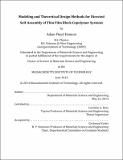Modeling and theoretical design methods for directed self-assembly of thin film block copolymer systems
Author(s)
Hannon, Adam Floyd
DownloadFull printable version (24.10Mb)
Other Contributors
Massachusetts Institute of Technology. Department of Materials Science and Engineering.
Advisor
Caroline A. Ross.
Terms of use
Metadata
Show full item recordAbstract
Block copolymers (BCPs) have become a highly studied material for lithographic applications due to their ability to self-assemble into complex periodic patterns with feature resolutions ranging from a few to 100s nm. BCPs form a wide variety of patterns due the combination of their enthalpic interactions promoting immiscibility between the blocks and the bonding constraint through their chain topology. The morphologies formed can be tailored through a directed self-assembly (DSA) process using chemical or topographical templates to achieve a desired thin film pattern. This method combines the traditional top-down lithographic methods with the bottom-up self-assembly process to obtain greater control over long range order, the local morphology, and overall throughput of the patterns produced. This work looks at key modeling challenges in optimizing BCP DSA to achieve precision morphology control, reproducibility, and defect control. Modeling techniques based on field theoretic simulations are used to both characterize and predict the morphological behavior of a variety of BCPs under a variety of processing conditions including solvent annealing and DSA under topographical boundary conditions. These methods aid experimental studies by saving time in performing experiments over wide parameter spaces as well as elucidating information that may not be available by current experimental techniques. Both forward simulation approaches are studied where parameters are varied over a wide range with phase diagrams of potential morphologies characterized and inverse design approaches where given target patterns are taken as simulation input and required conditions to produce those patterns are outputted from the simulation for experimental testing. The studies ultimately help identify the key control parameters in BCP DSA and enable a vast array of possible utility in the field.
Description
Thesis: Sc. D., Massachusetts Institute of Technology, Department of Materials Science and Engineering, 2014. This electronic version was submitted by the student author. The certified thesis is available in the Institute Archives and Special Collections. Cataloged from PDF version of thesis. Includes bibliographical references (pages 321-324).
Date issued
2014Department
Massachusetts Institute of Technology. Department of Materials Science and EngineeringPublisher
Massachusetts Institute of Technology
Keywords
Materials Science and Engineering.